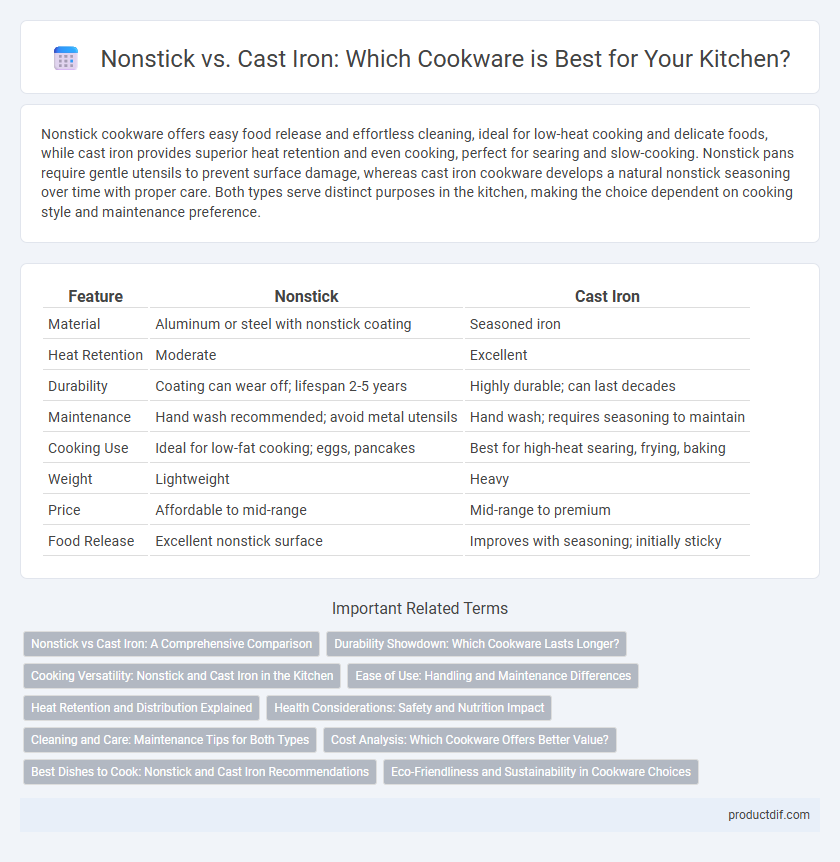Nonstick cookware offers easy food release and effortless cleaning, ideal for low-heat cooking and delicate foods, while cast iron provides superior heat retention and even cooking, perfect for searing and slow-cooking. Nonstick pans require gentle utensils to prevent surface damage, whereas cast iron cookware develops a natural nonstick seasoning over time with proper care. Both types serve distinct purposes in the kitchen, making the choice dependent on cooking style and maintenance preference.
Table of Comparison
| Feature | Nonstick | Cast Iron |
|---|---|---|
| Material | Aluminum or steel with nonstick coating | Seasoned iron |
| Heat Retention | Moderate | Excellent |
| Durability | Coating can wear off; lifespan 2-5 years | Highly durable; can last decades |
| Maintenance | Hand wash recommended; avoid metal utensils | Hand wash; requires seasoning to maintain |
| Cooking Use | Ideal for low-fat cooking; eggs, pancakes | Best for high-heat searing, frying, baking |
| Weight | Lightweight | Heavy |
| Price | Affordable to mid-range | Mid-range to premium |
| Food Release | Excellent nonstick surface | Improves with seasoning; initially sticky |
Nonstick vs Cast Iron: A Comprehensive Comparison
Nonstick cookware offers superior convenience with easy food release and simple cleanup, ideal for low-fat cooking, while cast iron excels in heat retention and durability, providing natural nonstick seasoning over time. Cast iron's ability to withstand high temperatures makes it perfect for searing and oven use, whereas nonstick pans are better suited for delicate foods and lower-temperature cooking. Choosing between nonstick and cast iron depends on cooking style preferences, maintenance willingness, and desired cookware lifespan.
Durability Showdown: Which Cookware Lasts Longer?
Cast iron cookware is renowned for its exceptional durability, often lasting a lifetime when properly seasoned and maintained, resisting warping and scratches. Nonstick cookware, while convenient and easy to clean, generally has a shorter lifespan due to coating degradation from high heat and abrasive utensils. Investing in cast iron offers long-term durability and even heat distribution, making it a superior choice for lasting kitchenware.
Cooking Versatility: Nonstick and Cast Iron in the Kitchen
Nonstick cookware excels in low-fat cooking and delicate foods like eggs and pancakes, offering easy food release and quick cleanup. Cast iron provides superior heat retention and is ideal for high-heat searing, frying, and oven use, enhancing flavors through seasoning over time. Both nonstick and cast iron serve distinct roles in kitchen versatility, with nonstick catering to convenience and cast iron delivering durability and exceptional heat control.
Ease of Use: Handling and Maintenance Differences
Nonstick cookware offers lightweight handling and effortless food release, making it ideal for quick, low-fat cooking and easy cleaning with mild detergents. Cast iron requires proper seasoning and careful drying to maintain its nonstick surface, making maintenance more labor-intensive, but it provides superior heat retention and durability. Users often find nonstick pans more convenient for everyday meals, while cast iron demands more attention but rewards with enhanced cooking performance over time.
Heat Retention and Distribution Explained
Cast iron cookware excels in heat retention, maintaining consistent temperatures ideal for slow cooking and searing, while nonstick pans heat up quickly but lose heat faster. Even heat distribution in cast iron prevents hot spots, ensuring uniform cooking, whereas nonstick surfaces may have less consistent heat spread due to thinner construction. Both options offer distinct thermal performance, with cast iron favored for durability and steady heat, and nonstick chosen for rapid heating and ease of use.
Health Considerations: Safety and Nutrition Impact
Nonstick cookware typically uses a synthetic coating like PTFE, which can release toxic fumes if overheated above 500degF, posing health risks. Cast iron cookware, while free of synthetic chemicals, can leach small amounts of iron into food, potentially benefiting individuals with iron deficiency but posing risks for those with hemochromatosis. Choosing between nonstick and cast iron depends on balancing concerns about chemical exposure with iron intake and cooking habits.
Cleaning and Care: Maintenance Tips for Both Types
Nonstick cookware requires gentle cleaning with soft sponges and non-abrasive detergents to preserve its coating. Cast iron benefits from thorough drying and occasional seasoning with oil to prevent rust and maintain its natural nonstick surface. Avoid soaking cast iron and never use harsh chemicals on nonstick to extend the lifespan of both kitchenware types.
Cost Analysis: Which Cookware Offers Better Value?
Nonstick cookware typically has a lower upfront cost, ranging from $20 to $100, but its shorter lifespan and need for periodic replacement can lead to higher long-term expenses. Cast iron pans, though initially pricier at $30 to $150, offer exceptional durability and can last decades with proper care, providing superior value over time. Considering maintenance, performance, and longevity, cast iron delivers better overall cost efficiency despite the initial investment.
Best Dishes to Cook: Nonstick and Cast Iron Recommendations
Nonstick pans excel at cooking delicate dishes like eggs, pancakes, and sauteed vegetables due to their smooth surface and easy-release properties. Cast iron skillets are ideal for searing steaks, frying chicken, and baking cornbread, providing superior heat retention and even cooking. Each type of cookware enhances specific recipes, with nonstick perfect for low-fat cooking and cast iron offering robust flavors and excellent browning.
Eco-Friendliness and Sustainability in Cookware Choices
Nonstick cookware often contains synthetic coatings that can degrade over time, releasing harmful chemicals and contributing to environmental pollution. Cast iron, made from natural materials, is highly durable and can last for generations, reducing the need for frequent replacement and minimizing waste. Choosing cast iron supports sustainability through its longevity, recyclability, and energy-efficient heat retention, making it a more eco-friendly option compared to conventional nonstick pans.
Nonstick vs Cast Iron Infographic

 productdif.com
productdif.com